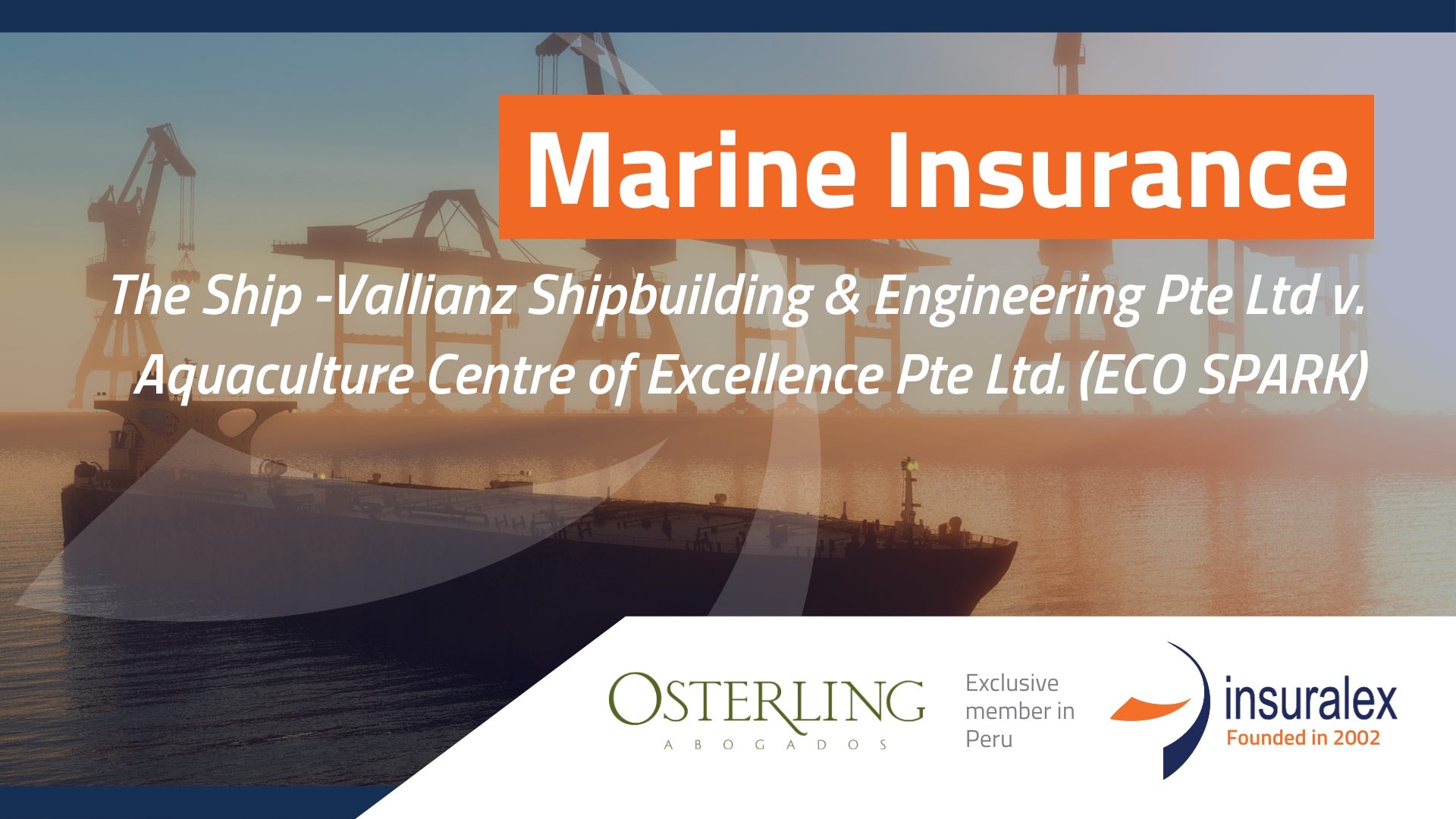
The Ship -Vallianz Shipbuilding & Engineering Pte Ltd v. Aquaculture Centre of Excellence Pte Ltd. (ECO SPARK)
Judgment of the High Court of Singapore [2023] SGHC 353 – 18 Dec 2023
Admiralty and Shipping — Admiralty jurisdiction and arrest — Action in rem — Definition of “ship” under section 2 of the High Court (Admiralty Jurisdiction) Act 1961 — Meaning of “vessel used in navigation” — Whether barge converted to floating fish farm is a “ship” under section 2 of the High Court (Admiralty Jurisdiction) Act 1961.
1. Summary.
On December 18, 2023, the General Division of the High Court of The Republic of Singapore issued a judgment on Summons No 1070 of 2023, between Vallianz Shipbuilding & Engineering Pte Ltd (hereinafter the “Plaintiff”) and Aquaculture Centre of Excellence Pte Ltd (hereinafter the “Defendant”).
The main discussion revolves around whether the vessel, owned by Defendant, is indeed a ship, to determine the validity of invoking the court’s admiralty jurisdiction, as Plaintiff has done. As discussed below, the Court found in favour of the Plaintiff, upholding admiralty jurisdiction over the dispute.
2. Background.
On January 15, 2021, the Defendant purchased the vessel “WINDBUILD 73” (hereinafter, the “Vessel”), which was a barge situated in a shipyard in Batam, Indonesia (the ¨Shipyard¨).
According to the contract between the Plaintiff and the Defendant dated 21 January 2021 (the “Contract”), the Plaintiff agreed to convert the Vessel at the Shipyard into a “Special Service Floating Fish Farm”, to be named the “ECO SPARK”.
The Vessel was to be converted following the rules and instructions under the special survey of the ship classification society Bureau Veritas (“BV”) and was to be distinguished in the register of BV by the symbol “I+ Hull Special Service – Floating Fish Farm, Coastal Area”. The parties agreed that the Vessel was to be delivered to “Singapore Farm Site FC131E at Serangoon Harbour” (the “Farm Site”) by 18 May 2021.
On 22 June 2021, the parties entered Addendum No. 1 to the Contract to revise the delivery date to accommodate the Defendant’s delay in providing the construction drawings for the conversion of the barge and equipment to be installed on the Vessel.
The Plaintiff tendered a Notice of Readiness on 14 February 2022 and the Vessel was launched on 21 February 2022 in Batam, Indonesia. On 27 February 2022, the Vessel was
towed by an ocean tug from the Shipyard to Singapore for physical delivery to the Defendant.
After the delivery of the Vessel, payment disputes arose under Addendum No. 1. On the one hand, the Plaintiff claimed outstanding payment amounting to S$1,642,363.62, including the 95% conversion fee of the Vessel. On the other hand, the Defendant asserted a counterclaim of S$1,300,573.35, citing incomplete construction under the contract.
On March 14, 2023, the Plaintiff initiated legal proceedings and simultaneously obtained an arrest warrant against the Vessel, now named ECO SPARK.
3. Judicial Process.
The judge determined that there were two issues to consider in this case. The first was to determine whether the ECO SPARK fell within the definition of “ship” under section 2 of the High Court (Admiralty Jurisdiction) Act 1961 (2020 Rev Ed) (“HCAJA”). The second was to decide whether the Vessel should be released from arrest, with this determination being contingent on the answer to the first question.
3.1. Position of the parties.
3.1.1 Defendant argued that the ECO SPARK was not a ship since it was a floating fish farm and lacked the characteristics of a ship, such as engines or self-propulsion, navigation equipment, transportation of people, cargo, or objects, registration with any flag state, and immobility, among others.
3.2.1 Plaintiff argued that the ECO SPARK was a barge before conversion and retained such nature and functionality despite the post-conversion state. It did not need to be self-propelled, and this did not affect its classification as a ship. After conversion, the Vessel was launched from the Shipyard and towed to Singapore like any other barge, among other reasons.
3.2. Position of the Judge.
The judge began his analysis by examining the definition of “ship”. Specifically, he referred to section 2 of the HCAJA, which stated that a ship includes any description of vessels used in navigation. However, the term “vessel” was not defined in the HCAJA. The judge then turned to the Interpretation Act 1965, which indicated that the term “vessel” includes floating craft of every description. Moreover, he considered guidance from SUM 1070, which included the phrase “used in navigation”. The judge noted that a crucial question was whether the court should consider the design and capability of the vessel to be used in navigation.
The judge decided that it was necessary to rely on the principles established by the HCAJA and referred to international jurisprudence to clarify the concept of a ship. In this way, the judge reviewed several judgments issued by the courts of England, Ireland, Australia, and Canada, where certain similarities existed regarding the term “navigability.”
Ultimately, the judge concluded that the concept of a ship involved a series of factors that needed to be considered. Despite not meeting all the factors, a vessel could still be considered a ship. Thus, the judge proceeded to identify various factors deemed crucial in determining whether a vessel was a ship.
1. Regarding physical characteristics, the judge specified that the vessel must have the ability to be self-propelled, possess a rudder, and handle a ship’s crew, navigation lights, and ballast tanks.
2. Regarding the design and capability to be used in navigation, the judge indicated that the current use of the vessel for navigation was a requirement, understanding the ability of a structure to move or be moved from one place to another. In this regard, he pointed out that there were three (3) elements for this navigational function: i) the degree of stability of the vessel, ii) its manoeuvrability, and iii) its stationary appearance.
3. Regarding stability, the issue is whether the vessel can move stably in the water. The second point considers whether manoeuvring is difficult. The third point concerns immobilisers to the vessel and the work required for its mooring to make navigation possible.
4. The judge also determined that, due to the vessel’s navigational capability being linked to its past use, this factor is relevant in determining whether it is ultimately considered a ship.
Considering all the mentioned factors, the judge noted that there is no dispute that the ECO SPARK is a floating fish farm and lacks engines or the ability to be self-propelled. He also found that the ECO SPARK lacks navigation equipment and does not transport people, cargo, or objects from one place to another. However, all these factors were not determinative in indicating that the Vessel was not a ship.
The judge found that after its conversion into the current ECO SPARK, the Vessel was capable of being used in navigation for its arrival at the conversion site. That is, despite the conversion work, it was launched in the Shipyard and towed. Moreover, the voyage initiated in open waters involved declaring the Vessel as a ship to port authorities in Marinet and obtaining prior authorization from the destination port, activities commonly associated with maritime navigation vessels.
Thus, the judge supported the Plaintiff’s position, indicating that the evidence showed that the spuds were removable and retractable, indicating that the vessel is not permanently stationary. Furthermore, the fact that the vessel was towed from the Batam Shipyard to Singapore demonstrated her stability, navigability, and capability for use in navigation.
Based on everything mentioned, the judge determined that:
i) The Vessel ECO SPARK was indeed considered a ship according to the definition provided in section 2 of the HCAJA. Consequently, the admiralty jurisdiction of the court was properly invoked by the Plaintiff.
ii) The Defendant’s request to lift the arrest of the Vessel ECO SPARK was dismissed. Accordingly, the Court rejected the Defendant’s claim for damages due to the vessel’s detention.
iii) The Defendant’s appeal in SUM 1.070 was dismissed, except for the request for a 20 ADM suspension in favour of arbitration.
For further contact Insuralex Peru / Osterling Abogados:




